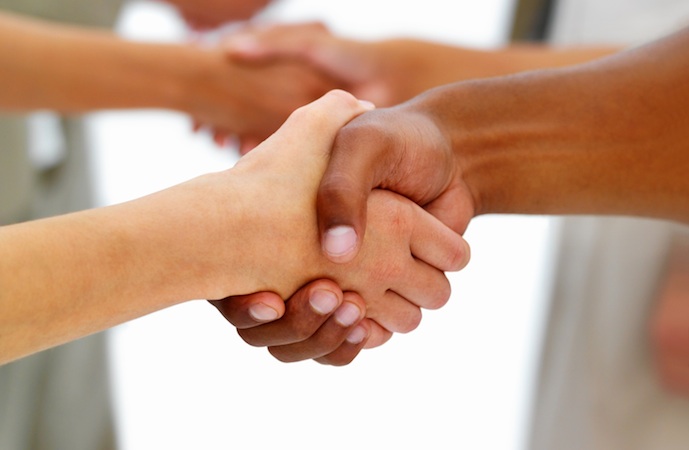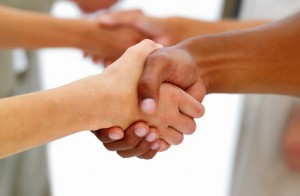#SolutionsMonday: Let’s All Meet Each Other
By Isaac Butler
Perhaps this is a no-brainer, but what is called intergroup contact (hanging out with people who aren’t like you) is often touted as an important way to mitigate implicit bias and lower racial anxiety. We even briefly brought up intergroup contact earlier when discussing implicit bias.
As the work of our research advisor Linda Tropp has shown, when people feel a connection to others outside of their group, they feel connected and both racial anxiety and bias decreases.
Since we talk about it so often in the news (and on this site) let’s go ahead and discuss intergroup contact in terms of white and black people. Positive intergroup contact is actually of great benefit to both. Not only does it reduce both black and white racial anxiety, but it also helps create resilience. That is to say, the next time that people are in mixed-race groups, it makes contact easier, even when those situations are fraught. Positive intergroup contact also makes future contact more likely.
Obviously, the struggle is making sure that intergroup contact remains positive. Fraught, stressful, and negative interracial interaction is only going to reinforce people’s bias, anxiety and reluctance. It’s not always guaranteed that hanging out with people is going to go well. This is as true for interracial interaction as anything else.
So here’s some things that can help facilitate positive intergroup contact:
- Create a shared sense of identity. As we see in cooperative learning or on sports teams, creating a sense that the group has its own identity and goals beyond simply being made up of individuals. Using a shared identity and goals can help create trust and rapport.
- But don’t erase difference. As we’ve written about earlier, ignoring difference can have serious negative consequences. Don’t force everyone to go along to get along, instead acknowledge and celebrate difference.
- Specifically address differences after relationships have developed. We all know that race is a fraught subject in America even under the best of circumstances. It’s easier to discuss differences and their impacts in an environment of shared norms and mutual trust. Creating that can take time.
These all apply to direct contact. But there is another kind of intergroup contact, generally called indirect contact or extended contact.
We live in a time of increased racial segregation in many areas of our lives. Because of that, sustained interracial interaction may not always be easy to achieve. Yet sustained interracial interaction is what we need.
As a result, researchers have started developing strategies that can facilitate positive interracial dynamics even among racially homogenous groups. The goal here is to enhance attitudes towards other racial groups and to lower anxiety about potential interaction with people of other races.
Thus, the extended contact effect. How extended contact works is this: Let’s say you’re white and you don’t really know a lot of black people. Your friend Terry, who is also white, has black friends. It turns out that knowing this can help positively shift your attitudes and expectations about hanging out with black people and make that interaction easier when it actually happens.
One study in California, for example, found that the extended contact effect helped reduce prejudice towards Mexican Americans amongst white subjects. In other words, simply knowing white people who had Mexican American friends made white people less prejudiced towards Mexican Americans even when they had very little actual direct contact.
Two things become clear from this body of research. First, extended contact helps reduce racial anxiety. To use a somewhat ridiculous simile, it’s kind of like when you’re a kid and you see a friend of yours successful nail some physical feat you’ve been frightened to try. If they can do it, so can you.
Second, this shows how important norms are to governing behavior, expectations and attitudes. If you’re white and know other white people with friends who aren’t white, that normalizes interracial friendships, and makes interracial contact more acceptable. This provides some interesting options for addressing prejudice and racial anxiety in racially homogenous environments, which, given the high rates of segregation in k-12 education, is vital.


